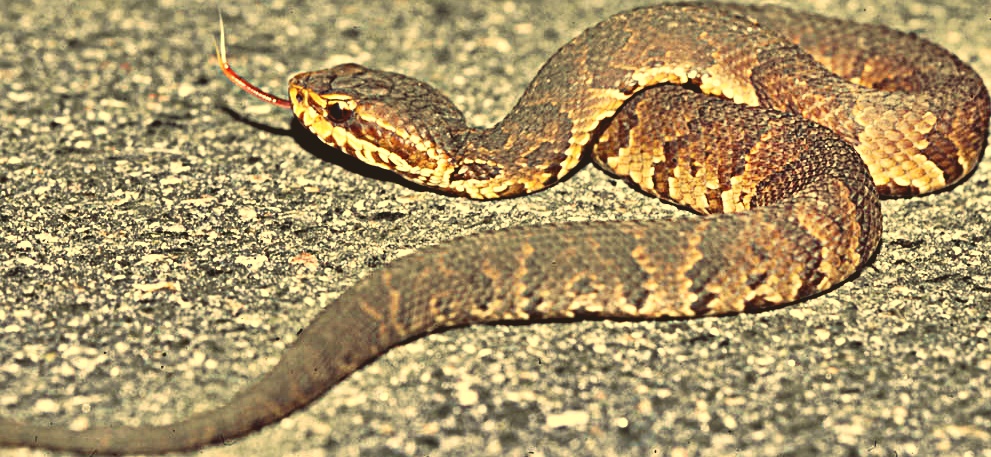
The cottonmouth snake is the only poisonous water snake in North America. It has a distinctive triangular, block-like head, a fatal bite, and a thickened body. They are also known as water moccasins. They tend to attack when they feel in danger or threatened. But instances of these snakes biting humans are very rare. They are semi-aquatic creatures and can found basking on ground or swimming in freshwater areas. They are natively found in the southeastern region of the United States.
Cottonmouths are pit vipers, just like rattlesnakes and copperheads. Just like all pit viper snakes, water moccasins also feature heat-sensing pits on their face between their nostrils and eyes. The pits are able to sense even the smallest of changes in temperature, which allows the snake to strike the heat source (mostly a food source/prey) with deadly accuracy.
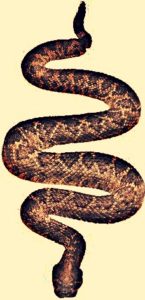
The inside area of the mouth of a water moccasin is white in color and hence the name cottonmouth. It is also locally referred to by other names like mangrove rattler, stub-tail snake, black moccasin, water pilot, gaper, snap jaw, swamp lion, water mamba, and trap jaw.
There are 3 subspecies of cottonmouths, i.e., Florida, western, and eastern water moccasins.
Cottonmouth Snake – What does it look like?
Cottonmouths are comparatively big and can grow anywhere between 2 to 4 feet in length. Males are bigger than females. The venom glands are located in large jowls; they have cat-like elliptical pupils with a dark line across the eye, and big triangular heads. Unlike other snakes that have no visible neck, the big heads of cottonmouths are distinct from the thin necks. The snouts are pale and dark bands are present by each nostril.
They have muscular thick bodies which make them seem fat as compared to their overall length. The body is covered with ridged or keeled scales. The color of the bodies vary from olive or yellowish to dark brown or completely black, along with brilliant stripes of yellow or brown colors. The belly is paler as compared to the back and usually features brownish-yellow or dark patches. The bottom area of the tail is black in color.

Older adult cottonmouths feature solid, dark colors. However, baby and young adult water moccasins are light brown in color with bright sulfur-colored bands of all across. These patterns fade away as they age. The tail tips of juveniles have a distinctive bright yellow color which is used by them to draw prey like frogs, etc located in the vicinity. They slowly wave their tails to attract, kill, and eat the prey.
Cottonmouth snakes – Food and Reproduction
Cottonmouths typically swim on the surface of water with the head peeping out. They are found all year round, during daytime as well as nighttime. They however mainly hunt for prey after dark, primarily during summers. Their diet consists of small mammals, fish, amphibians, birds, turtles, lizards, and baby alligators. They also eat other snakes, which include smaller cottonmouths.
The snake mates in the spring season. During the process of mating, male water moccasins attract the females by slithering around and undulating their tails. This act is also to draw females away from other male suitors. The males will also fight with other male cottonmouths for mating with a female.
Cottonmouths are ovoviviparous creatures, meaning that incubation of the eggs occur inside the body of the mother. The gestation period is for 3 to 4 months. Live baby snakes, in litters of around 9 to 19, are birthed by the mother once in 2 to 3 years. Baby cottonmouths have bright colors and do not start slithering just after birth. They are not taken care of by the parents.
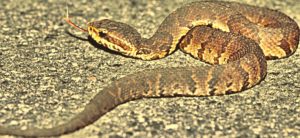
Water Moccasin habitats
Cottonmouths are found in the southeastern part of the US, from Florida to southern Virginia and east Texas.
They usually live in marshes, swamps, and drainage pits as well as on the borders of lakes, ponds, and streams. They can be found near fields and small water bodies on land. They often tend to soak up the sun on stones, tree branches, and logs present near the edge of a water source. The body of cottonmouths chills rapidly when in water and hence they bask in the sun to raise the body temperature.
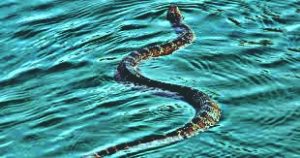
Cottonmouth snake – bite and behaviors
Cottonmouths are thought to be real aggressive snakes. However, the fact is that they rare bite people. But unlike non-poisonous snakes that flee from dangers, water moccasins tend to stand their ground and fight the threats.
Whenever the snake feels that it is under threat, it will coil up its body and fully open its mouth to show the distinctive white color of the inside area of the mouth. The bright white color can be quite striking to look at, especially when compared to the dark browning or nearly blackish bodies of adult cottonmouths. Opening the mouth and displaying the white interiors serve as a warning from the snake to potential threats or predators.
The venom of cottonmouths is very powerful. It is primarily made of hemotoxins that disintegrate blood cells and prevent the coagulation or clotting of blood. A water moccasin bite can be really serious or even life-threatening. Human fatalities from a cottonmouth bite is however really rare. The hemotoxins present in the venom cause hemorrhaging all across the body’s circulatory system, in all the places where the poison has spread.
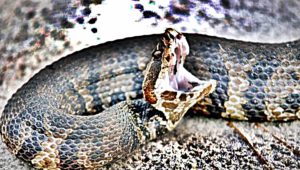
The injection and spread of cottonmouth venom can result in short-term or permanent damage to muscles and tissues, internal bleeding, and intense pain on the area where the bite occurred. Depending on which part of the body the snake bit, there may also be loss or damage of an extremity. It is important for to immediately seek medical attention after being bitten by a cottonmouth. Antivenin for the snake’s venom is available.
One can prevent water moccasin bites by quickly walking away from the snake whenever you encounter it. If it is in the neighborhood, then a professional needs to be hired to get rid of the snake. Remove all possible hiding places for snakes like rock piles, thick bushes, etc., to prevent cottonmouths from living near your house.
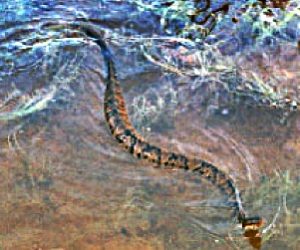
Leave a Reply